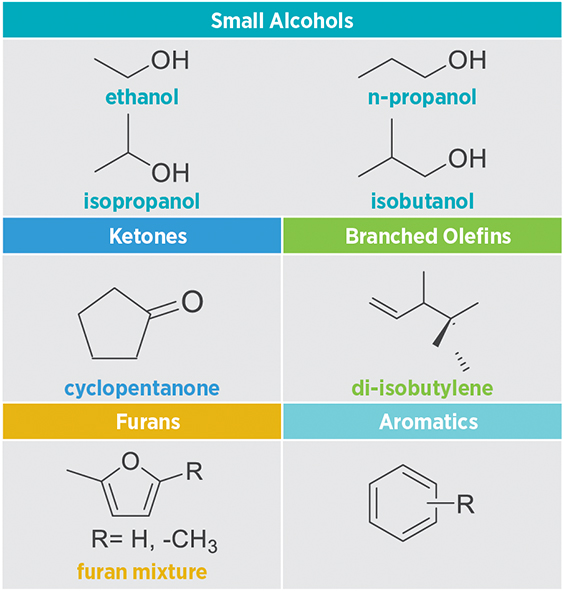Breakthroughs Move Researchers One Step Closer to $35 Billion Fuel Savings

Co-Optima researchers identified representative blendstocks from five chemical families with the greatest promise for reducing energy consumption, improving air quality, and lowering drivers' costs. Figure courtesy of Sandia National Laboratories
The National Renewable Energy Laboratory (NREL) and its partners recently revealed breakthroughs in identification of fuel blendstocks for the U.S. Department of Energy (DOE) Co-Optimization of Fuels & Engines (Co-Optima) initiative. This national research effort is providing industry with the scientific underpinnings needed to accelerate introduction of high-performance fuels and engines that reduce energy consumption, improve air quality, and lower drivers' costs. Two new studies reveal how fundamental research has identified representative blendstocks from five chemical families with the greatest promise for meeting these targets.
In 2017, U.S. petroleum consumption set a record of 9.8 million barrels per day, with transportation accounting for 70% of that fuel use. Combined with other R&D already underway, Co-Optima strategies present the opportunity to save American consumers and commercial truck operators as much as $35 billion dollars per year at the pump, while maximizing vehicle performance and efficiency, leveraging domestic fuel resources, boosting jobs, and enhancing energy security.
"Pinpointing the fuel options that show strong potential to meet these targets is a huge step in moving this research forward," says Co-Optima Project Leader and NREL Vehicle Technologies Program Manager John Farrell. "The trick has been to balance scientific objectivity with an understanding of market factors and focus on properties that make it possible to boost engine efficiency and performance, are compatible with petroleum-based fuels and infrastructure, and can eventually be produced at commercial scale."
Much of the Co-Optima research is focused on components known as blendstocks, which can be produced from a wide spectrum of domestic resources, including natural gas, petroleum―or biomass. These bio-blendstocks could be produced using renewable, non-food, domestic biomass such as forestry and agricultural waste. They have the potential to create much-needed new jobs in farm country, while leveraging a billion-ton annual feedstock reserve and keeping energy dollars in America.
As described in Fuel Blendstocks with the Potential to Optimize Boosted Spark-Ignition Engine Performance, Co-Optima researchers have identified representative blendstocks from five chemical families—alcohols, ketones, furans, alkenes, and high-aromatics mixtures—that demonstrate the greatest promise of delivering fuel properties that meet performance requirements and have the potential to be produced at commercial scale. These bio-blendstocks offer the potential to deliver high efficiency and performance when combined with petroleum-based fuel in optimized engines.
The second study, Efficiency Merit Function for Spark-Ignition Engines, explains how the Co-Optima merit function framework has made this breakthrough possible, by quantifying the effects of fuel properties on engine performance. The merit function weighs the relative importance of critical fuel properties—including research octane number, octane sensitivity, and heat of vaporization—in relation to spark ignition engine efficiency. Combined with a previously unimaginable wealth of fuel property data compiled for this initiative, the merit function has dramatically changed how researchers think and talk about fuels.
In addition to researchers' work in the lab, Co-Optima analysts are developing a comprehensive understanding of the cost, market, and air quality implications, benefits, and tradeoffs involved in producing these blendstocks from domestic biomass. Ultimately, this early-stage R&D will provide fuel producers with greater flexibility in delivering fuels needed to put the most efficient and high-performance cars and trucks on the road.
This first-of-its-kind NREL-led initiative leverages synergies across DOE's Office of Energy Efficiency and Renewable Energy and the national lab system to amplify research efficiencies and innovation. This widespread collaboration, helmed by DOE's Vehicle Technologies Office and Bioenergy Technologies Office, relies on the research expertise of nine national laboratories and 13 university partners, as well as ongoing engagement with representatives from a wide range of stakeholders and government agencies.
Last Updated May 28, 2025
